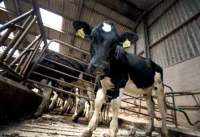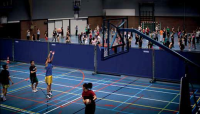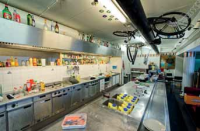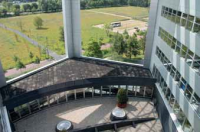Slipping on the Forum bridge
Every day thousands of cyclists speed across the bridge leading to the Forum. Following a spate of painful falls back in January, barriers sealed off the wooden bridge and cyclists had to make a detour.
 The closure immediately prompted a great deal of agitation on our website. Students who race over the bridge every day could hardly believe that it was dangerous. Weren’t the tumbles simply bad luck and the university’s response overly cautious? Complaints were also voiced about ‘internationals’ who have little cycling experience and make Wageningen’s roads unsafe. To the university, however, the problems didn’t come as a complete surprise. Although the bridge is coated in an anti-slip material, the surface does become slippery as soon as the temperature drops below zero. When the bridge became treacherous at temperatures above zero, however, it was the last straw. Something had to be done. Although the barriers were removed as the spring weather set in, the problem is still being tackled. Experiments are being carried out with anti-slip strips (they are still visible on the bridge)
The closure immediately prompted a great deal of agitation on our website. Students who race over the bridge every day could hardly believe that it was dangerous. Weren’t the tumbles simply bad luck and the university’s response overly cautious? Complaints were also voiced about ‘internationals’ who have little cycling experience and make Wageningen’s roads unsafe. To the university, however, the problems didn’t come as a complete surprise. Although the bridge is coated in an anti-slip material, the surface does become slippery as soon as the temperature drops below zero. When the bridge became treacherous at temperatures above zero, however, it was the last straw. Something had to be done. Although the barriers were removed as the spring weather set in, the problem is still being tackled. Experiments are being carried out with anti-slip strips (they are still visible on the bridge)
. In view of these efforts, Ad van der Have of Facilities & Services expects that the problem will have been solved bynext winter. ‘We don’t want another winter faffing around with barriers.’
Thank you, God!
‘I thank God that I was able to complete this thesis.’ Since this spring, PhD students may once again include such words of thanks in the acknowledgements in their thesis.
PhD student Jerke de Vries brought this issue into the limelight in January. He insisted on his right to thank his Creator in his thesis. Officially, there was a taboo on this at the time. The rules had been set down succinctly at the start of the academic year by dean Johan van Arendonk (academic board) and circulated to professors. Religious statements had no place in a Wageningen thesis. De Vries took no notice of the rule, was obliged at the last minute to scrap the offending text and chose to tear the whole of his acknowledgements out of his book. This led to a nationwide commotion. The academic board proceeded to add water to the wine. You are now permitted to thank god, but religious or political statements are forbidden. Anyone who imagines that Wageningen PhD graduates now all invoke God in their afterword is mistaken. Nor have there been any conflicts yet, says Simon Vink spokesman for the executive board. ‘Occasionally a professor has asked whether a certain formulation counted as a statement or as an expression of thanks.’ So in practice, the rule seems to work. But it is not yet on paper. Legal advisors are currently poring over the question of how to sum up the distinction between an expression of thanks and a statement in unambiguous language.’
Aalt leaves, Aaltje arrives
A twittering calf turned out to the perfect farewell gift for departing chairman of the Wageningen UR board Aalt Dijkhuizen last December.

Via @AaltjeDairyCamp, little Aaltje shared with the world her enthusiasm for ‘cool yellow ear things’ and fresh straw. As soon as the Christmas holiday came around, big Aalt visited his namesake in Leeuwarden. Happily, a few months on, Nelleke Meindertsma, communication staff member at the Dairy Campus is able to report that Aaltje is still brimming with health: ‘Her carers say her hide is looking good.’ What’s more, in just a hundred days she has grown from 40 to 120 kg. Although she currently does little more than ‘eat, poop and sleep’, Aaltje is already participating in some Wageningen research. She is part of research projects related to smart dairy farming, says Kees Lokhorst, senior researcher with Livestock Research. Sensors are measuring exactly how much the cows eat, drink, walk and weigh. Besides this, some of Aaltje’s hair has been taken so that her genetic material can be established. For breeders this should clarify what genes can reveal about a cow’s ultimate lifespan and performance. As well as the best way to care for an animal over the course of its life. And on Twitter too, Aaltje is setting her best foot forward. She has posed with visiting dignitaries and is tirelessly promoting Wageningen research. But the life of a celebrity calf is evidently a lonely one. After her hundredth day of life, Aaltje twittered sadly to all her 120 followers that she hadn’t received a single visit, or even any congratulations. Big Aalt, when are you coming to visit again?
Bongerd’s growth
The Bongerd Sports Centre is bursting at the seams, reported Resource last December. The growth in student numbers has created a pressing need for a new sports hall. How are the plans coming along?

A halt on new members for sports associations, late-night training, resorting to joining city clubs: these are all signs that Wageningen’s student sport is under extreme pressure. Which isn’t so strange when you consider that over the past four years the student population has increased by 57 percent, an average of 14 percent a year. This year the overflowing occupancy of the sports facilities was even evident in the National Student Survey: for the first time in years, the rating awarded by Wageningen students to their sports centre was down compared to the preceding year. But expanding a sports centre is no mean task, as Henri ten Klooster, head of the Bongerd, knows. Sport costs time and money. A lot of money. The various options were discussed in a recent memorandum to the Executive Board. The most probable option is a second sports hall attached to the present one, built where the tennis courts currently stand. To compensate for the loss of the courts, new tennis courts would be added to the Wageningen city club that is situated adjacent to the Bongerd, and which itself is struggling with a decline in membership. What’s more, the new hall will be able to seat 600 exam candidates. And there is no need for extra parking spaces, often a stumbling block in a construction project. According to Ten Klooster, the campus already provides ample parking. If and when the hall will be built is as yet unclear. Ten Klooster hopes approval will be given before the summer, so that construction can start in September 2015. But although the Executive Board has responded positively to the memorandum, it is not yet making any promises. The university is keen to examine whether the expansion fits within a ‘broader framework’ of expanding facilities and education capacity. Moreover, it is not clear whether there is enough money. This topic will be debated in the second week of July.
New incarnation
This is a student kitchen. Litres of deepfrying fat, a fair few alcoholic drink bottles and loads of accumulated paraphernalia.

Makes for a picture in which you keep seeing things you hadn’t noticed yet: like that bicycle draped over a beam or the chairs stuck to the ceiling in the background. But people who work at the administrative headquarters are probably struck by something else. Because this is not just any kitchen; it was once their canteen in their former office on the Costerweg. Since last August, about 180 students have been living here and it will be student accommodation for at least five years. This academic year the sober office corridors have been livened up with murals and the meeting rooms equipped with old sofas and crates of beer. And for all we know, the former offices of the executive board may now house the CEOs of the future. Those living on this corridor are lucky. They get a professional kitchen with their room, and they claim to make good use of it. Apparently, one resident is a qualified cook and prepares delicious steaks. In other words, the food in the canteen has only improved.
Calm before construction storm
While Helix has pretty much reached its highest point, behind the scenes plenty of hard work is being done on the next construction projects: Campus Plaza and the Incubator on the ‘Business Strip’ of the campus.
 The first spade must break ground for this complex of buildings before the end of the year. This tight schedule is still feasible, says Ad van der Have (Facilities & Services)
The first spade must break ground for this complex of buildings before the end of the year. This tight schedule is still feasible, says Ad van der Have (Facilities & Services)
. Yet final designs still aren’t available. ‘Recently we have been focused mainly on the zoning plan and everything related to it. Such as a visual quality plan for the entire Business Strip, which has now been completed. The zoning plan procedure is the critical path in the planning.’ Van der Have expects Wageningen’s municipal council to pass a decision on the plans in September/October. Meanwhile, the architects are working on the final design. Campus Plaza will broadly resemble the accompanying illustration produced by the firm SVP Architectuur en Stedenbouw in Amersfoort. The building will accommodate 400 student homes. On the ground floor 2200 square metres will be available for shops, including a small supermarket, hospitality and catering and a childcare centre. According to Van der Have 15 businesses have applied to date, including a supermarket, a bicycle repair shop and a bakery. Ten candidates have applied to provide the child care facilities.
Orion’s forbidden space
In the radiant presence of Queen Maxima the new education building Orion was opened in September. The whole of Orion? No, to this day a small part of the building remains hermetically sealed.

This obstinate little part of Orion is a terrace on the fourth floor. A handsome, elongated plateau with views of both the lower-lying indoor area and the south side of the campus. When the weather is fi ne, perhaps the nicest place to chill in the entire building. But it is inaccessible. Cause: an error by the building contractor. According to site manager Annemarie de Vries, the roofing was not properly laid. ‘It soon became clear that things had gone badly wrong,’ says De Vries, ‘rainwater was leaking straight through it.’ After persistently pursuing the inevitable question of who was to blame, the parties finally reached agreement this spring, which means the builders can get to work. De Vries is confident that the terrace will be completed during the summer holiday, although she won’t promise it. Visitors will soon be able to enter the terrace from two sides, and sit in comfortable chairs to enjoy a bite to eat from one of the snack dispensers. ‘It will be like a patio; a unique place on the campus.’ In the original design the lower-lying indoor area was intended to be planted with trees, but we can forget that idea. The necessary roof reinforcement was scrapped due to the cost. As yet, there are no plans for another use of the space.

